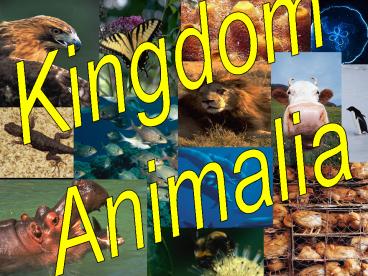Kingdom - PowerPoint PPT Presentation
1 / 42
Title:
Kingdom
Description:
1 Characteristic Of Animals Arthropod Diversity!! Characteristic Of Animals Arthropod Diversity!! Response Well developed nervous system with brain Sensitive organs ... – PowerPoint PPT presentation
Number of Views:149
Avg rating:3.0/5.0
Title: Kingdom
1
Kingdom Animalia
1
2
Characteristic Of Animals
Most are Motile
No Cell Walls
Heterotrophic
Multicellular
Eukaryotic
2
3
Animals are grouped according to the presence or
absence of a backbone.
Animals with backbones are called vertebrates
while animals without backbones are called
invertebrates.
3
4
4
5
Symmetry is the arrangement of body parts around
a central point or line.
5
6
InVertebrates
6
7
- Phyla of invertebrates include
- Porifera
- Cnidarian
- Flatworms
- Roundworms
- Segmented worms
- Mollusks
- Arthropods
- Echinoderms
in order of increasing complexity
7
8
Phylum Porifera
8
9
- Simple, multi-cellular animals
- No nervous system but some do react to stimuli by
producing toxins. - Live attached to hard surface - sessile
- Asymmetry
- Filter Feeders
9
10
Clip
- Ecology
- Habitat for marine animals
- Symbiotic relationships with
- green algae bacteria.
10
11
Clip
Phylum Cnidaria
11
12
Medusa
- Corals, Jellyfish, sea anemones, hydras
- Have nerve cells-nerve net- that can sense the
environment.
Polyp
- Can detect light through structures called ocelli.
- Immobilize and kill prey with stinging cells on
tentacles
Body Plan Radial Symmetry Have tissues
12
13
Clip
- Ecology
- Coral Reefs-Symbiosis with algae
- Calcium Carbonate
13
14
Phylum Plathyhelminthes
FLAT WORMS
14
15
Flatworms, liver flukes, tapeworms Usually
parasitic can be free living and carnivores Can
be aquatic or terrestrial
15
16
Body structure
- Soft, Flattened
- Have tissues and internal organs
- Have a simple nervous system.
- Bilaterally symmetrical
16
17
Cool Fact! They can regenerate missing parts and
even grow a new planaria from a piece of one!
17
18
Phylum Nematoda
ROUND WORMS
18
19
Roundworms, hookworms free-living and
parasitic aquatic and terrestrial Digestive
system with two openings
19
20
Movement Contracting muscles
- Body
- Unsegmented
- Pseudocoelom
- Digestive system with two openings
- Exchange gases through body walls-through
diffusion
20
21
not for the squeamish
22
Diseases caused by roundworms Trichinosis -In
humans, can be contracted by eating infected
pork. --5 of cases are fatal Ascarid
Worm Matures in the intestines of the
host Eating vegetables that are not
washed Hookworms Soil Walking barefoot anemia,
malnutrition, and in children causes
under-development
22
23
Phylum Annelida
SEGMENTED WORMS
23
24
- Segmented, Bilateral symmetry
- Two way gut
- -Feed by sucking in soil and decaying matter
- Closed system-blood vessels
- Ex Earthworms,
- leeches
24
25
Clip
- Ecology
- Recycling in nature
- Diet of many birds
- Diet of fish
25
26
(No Transcript)
27
Phylum Mollusca
27
28
- Latin mollus soft
- Examples snails, slugs, clams, squids, and
octopi. - 2nd Largest animal phylum on Earth
- Almost all habitats
- Soft-bodied animals, usually with a hard external
shell. - Some have lost the shell completely.
- Have internal organs
- Shells are made of calcium carbonate
28
29
Feeding Can be herbivores, carnivores, filter
feeders, detritivores, or parasites.
Clip
29
30
Spiders, insects, centipedes, scorpions, shrimp,
crabs, lobsters, butterflies
Phylum Arthropoda
30
31
- Major Characteristics
- Segmented bodies covered in an exoskeleton
- of chitin (Carbohydrate).
- Jointed appendages
- Legs, antennae
- Three segments
- Head, Thorax, Abdomen
31
32
(No Transcript)
33
- Exoskeleton
- Protection
- helps prevent water loss
- provides framework for muscle attachment
- Does not grow. When the organism outgrows it, it
molts. - Metamorphosis (Insects)
- Adult stage and larval stage do not compete for
food. - Can be herbivores, carnivores, and omnivores.
33
34
Circulation Open circulatory system Well
developed heart with arteries and vessels
Clip
Reproduction Internal fertilization land or
external Aquatic
Response Well developed nervous system with brain
Sensitive organs such as eyes and taste receptors
34
35
Arthropod Diversity!!
Clip
35
36
- UPS
- Bees, butterflies, etc., pollinate crops
- Some produce silk, wax, honey
- Food
Insects and Humans
- DOWNS
- Termites destroy wood
- Moths eat cloth
- Locusts destroy crops
- Cotton Boll Weevils
- Mosquitoes and diseases
36
37
Phylum Echinodermata
37
38
Spiny Skin 7,000 species Sea stars, sand
dollars, and sea urchins
Clip
38
39
Major Characteristics
- All are aquatic-marine
- Spiny skin
- Internal Skeleton
- Move with tube feet
- suction cup
- Sand dollars and sea urchins have moveable spines.
39
40
- Feeding
- Various methods
- Sea Star
- Pushes stomach out through its mouth (which is on
the underside) into a clam and then digests. - Can regenerate missing parts
40
41
Clip
- Ecology
- Major food source for other marine animals
- Carnivorous echinoderms help control populations
of clams - Crown of Thorns sea star destroys coral reef
systems.
41
42
Review of the Invertebrates Clip































